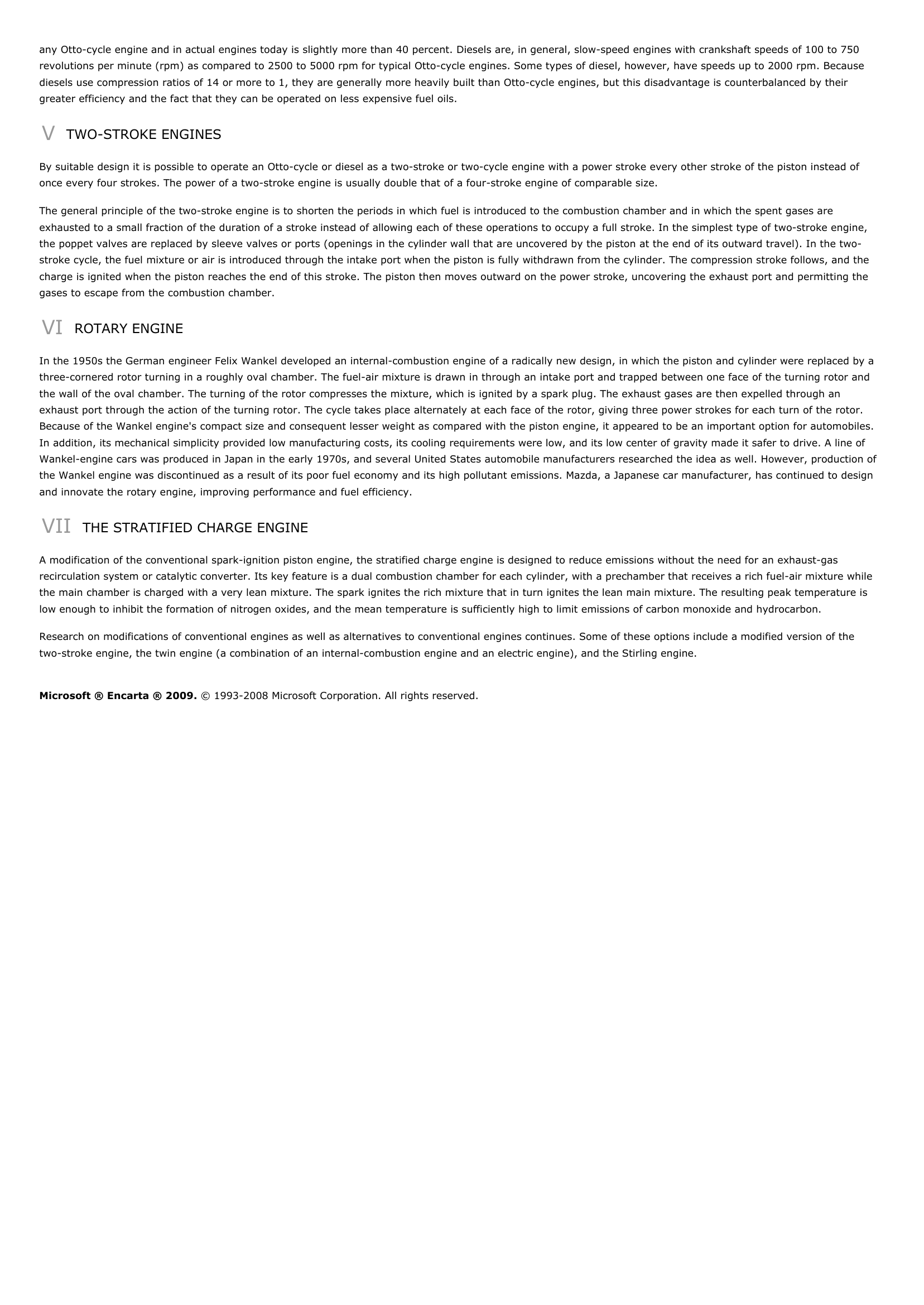Internal-Combustion Engine.
Publié le 11/05/2013
Extrait du document
«
any Otto-cycle engine and in actual engines today is slightly more than 40 percent.
Diesels are, in general, slow-speed engines with crankshaft speeds of 100 to 750revolutions per minute (rpm) as compared to 2500 to 5000 rpm for typical Otto-cycle engines.
Some types of diesel, however, have speeds up to 2000 rpm.
Becausediesels use compression ratios of 14 or more to 1, they are generally more heavily built than Otto-cycle engines, but this disadvantage is counterbalanced by theirgreater efficiency and the fact that they can be operated on less expensive fuel oils.
V TWO-STROKE ENGINES
By suitable design it is possible to operate an Otto-cycle or diesel as a two-stroke or two-cycle engine with a power stroke every other stroke of the piston instead ofonce every four strokes.
The power of a two-stroke engine is usually double that of a four-stroke engine of comparable size.
The general principle of the two-stroke engine is to shorten the periods in which fuel is introduced to the combustion chamber and in which the spent gases areexhausted to a small fraction of the duration of a stroke instead of allowing each of these operations to occupy a full stroke.
In the simplest type of two-stroke engine,the poppet valves are replaced by sleeve valves or ports (openings in the cylinder wall that are uncovered by the piston at the end of its outward travel).
In the two-stroke cycle, the fuel mixture or air is introduced through the intake port when the piston is fully withdrawn from the cylinder.
The compression stroke follows, and thecharge is ignited when the piston reaches the end of this stroke.
The piston then moves outward on the power stroke, uncovering the exhaust port and permitting thegases to escape from the combustion chamber.
VI ROTARY ENGINE
In the 1950s the German engineer Felix Wankel developed an internal-combustion engine of a radically new design, in which the piston and cylinder were replaced by athree-cornered rotor turning in a roughly oval chamber.
The fuel-air mixture is drawn in through an intake port and trapped between one face of the turning rotor andthe wall of the oval chamber.
The turning of the rotor compresses the mixture, which is ignited by a spark plug.
The exhaust gases are then expelled through anexhaust port through the action of the turning rotor.
The cycle takes place alternately at each face of the rotor, giving three power strokes for each turn of the rotor.Because of the Wankel engine's compact size and consequent lesser weight as compared with the piston engine, it appeared to be an important option for automobiles.In addition, its mechanical simplicity provided low manufacturing costs, its cooling requirements were low, and its low center of gravity made it safer to drive.
A line ofWankel-engine cars was produced in Japan in the early 1970s, and several United States automobile manufacturers researched the idea as well.
However, production ofthe Wankel engine was discontinued as a result of its poor fuel economy and its high pollutant emissions.
Mazda, a Japanese car manufacturer, has continued to designand innovate the rotary engine, improving performance and fuel efficiency.
VII THE STRATIFIED CHARGE ENGINE
A modification of the conventional spark-ignition piston engine, the stratified charge engine is designed to reduce emissions without the need for an exhaust-gasrecirculation system or catalytic converter.
Its key feature is a dual combustion chamber for each cylinder, with a prechamber that receives a rich fuel-air mixture whilethe main chamber is charged with a very lean mixture.
The spark ignites the rich mixture that in turn ignites the lean main mixture.
The resulting peak temperature islow enough to inhibit the formation of nitrogen oxides, and the mean temperature is sufficiently high to limit emissions of carbon monoxide and hydrocarbon.
Research on modifications of conventional engines as well as alternatives to conventional engines continues.
Some of these options include a modified version of thetwo-stroke engine, the twin engine (a combination of an internal-combustion engine and an electric engine), and the Stirling engine.
Microsoft ® Encarta ® 2009. © 1993-2008 Microsoft Corporation.
All rights reserved..
»
↓↓↓ APERÇU DU DOCUMENT ↓↓↓
Liens utiles
- Auto Racing: Notable Land Speed World Records All cars have gasoline-driven internal-combustion engines unless marked (E) for electric, (S) for steam, (T) for turbine, (J) for jet, or (R) for rocket.
- dispositif d’obtention de l’énergie électrique sans combustion
- pluies acides, phénomène résultant de la pollution de l'air par les oxydes de soufre produits par l'usage de combustibles fossiles riches en soufre, ainsi que par les oxydes d'azote qui se forment lors de toute combustion dans l'atmosphère.
- Steam Engine.
- combustion, retardateur de combustion, retardateur de, substance appliquée à un matériau pour en retarder la combustion.







